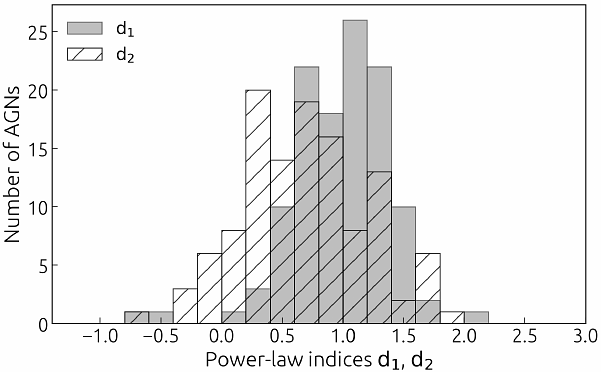MOJAVE -- XXII. Brightness temperature distributions and geometric profiles along parsec-scale AGN jets

MOJAVE -- XXII. Brightness temperature distributions and geometric profiles along parsec-scale AGN jets
E. V. Kravchenko, I. N. Pashchenko, D. C. Homan, Y. Y. Kovalev, M. L. Lister, A. B. Pushkarev, E. Ros, T. Savolainen
AbstractRadial gradients of the brightness temperatures along the parsec-scale jets of Active Galactic Nuclei (AGN) can be used to infer the energy balance and to estimate the parameter range of physical conditions in these regions. In this paper, we present a detailed study of the brightness temperature gradients and geometry profiles of relativistic jets of 447 AGN based on 15 GHz Very Long Baseline Array observations performed between 1994 and 2019. We used models of the jet structure using two-dimensional Gaussian components and analysed variations in their brightness temperatures and sizes along the jets. The size of the jet components, R, increases with projected distance from the jet base, r, as $R\propto r^{1.02\pm0.03}$, i.e., typically following a conically expanding streamline and therefore indicating that the size of jet components is a good tracer of jet geometry. The brightness temperature gradients along the jets typically follow a power-law $T_\mathrm{b} \propto r^{-2.82\pm0.07}$. Half of the sample sources show non-monotonic R(r) or Tb(r) profiles and their distributions were characterised by a double power-law model. We found at least six scenarios to explain the enhancement of the brightness temperature by a presence of inhomogeneities (shocks, jet recollimation) or curvature effects (helical structures, helical magnetic field, non-radial motion, bent jets). Our results are consistent with the scenario that the jet features can be simplified as optically thin moving blobs. In the sources demonstrating transition from a conical to parabolic jet shape, the gradient of the Tb(R) changes at the position of the break consistent with the model of magneto-hydrodynamic acceleration.